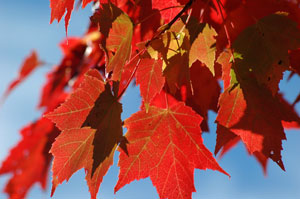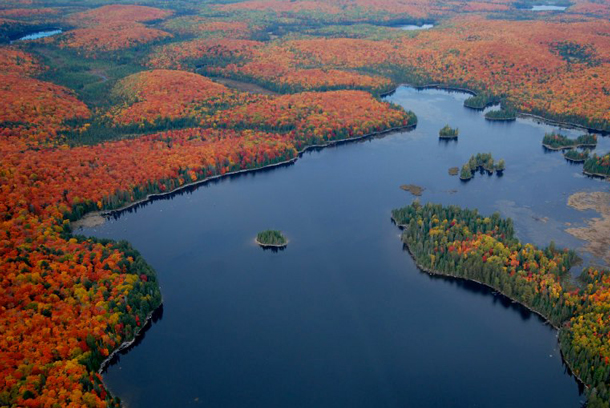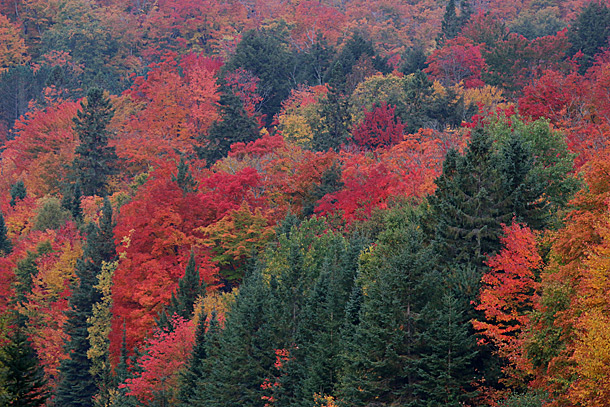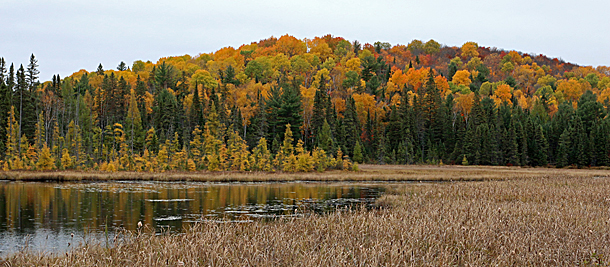Events Calendar
Current Weather
Why Does Fall Leaf Colour Change Happen?
The rolling hills of Algonquin Park's west side are simply ablaze with vibrant colours in late September and early October. In a landscape so often dominated by the green of summer, how does this brief explosion of reds, oranges, and yellows happen in the early autumn? The answer involves a complex process of numerous chemicals and environmental variables, which can be explained below.
Why All the Colours?
Image above: Fall colour near Smoke Lake in Algonquin Park on October 6, 2016 (click to enlarge).
 To get to the bottom of why these brilliant colours appear in the first place, we need to examine how a tree survives. Just like humans, trees need food. Trees manufacture their own food using light from the sun and converting it into sugar through a near miraculous process called photosynthesis. Photosynthesis is a complex chemical process that occurs in leaves using tiny chloroplast molecules containing chlorophyll, the green pigment normally seen in leaves during the spring and summer months. Chlorophyll found in green plants functions best when temperatures are warm and there is plenty of light such as during Algonquin's summers.
To get to the bottom of why these brilliant colours appear in the first place, we need to examine how a tree survives. Just like humans, trees need food. Trees manufacture their own food using light from the sun and converting it into sugar through a near miraculous process called photosynthesis. Photosynthesis is a complex chemical process that occurs in leaves using tiny chloroplast molecules containing chlorophyll, the green pigment normally seen in leaves during the spring and summer months. Chlorophyll found in green plants functions best when temperatures are warm and there is plenty of light such as during Algonquin's summers.
As the daylight length shortens, and temperatures grow cooler in autumn, trees slow and eventually halt their sugar making process of photosynthesis and begin to prepare for the dormant winter period. During this preparation for winter, trees extract the valued chemical components within their leaves, including the green chlorophyll, for re-use again next growing season (the following spring/summer). As these valued chemical components break down and get extracted from the leaf, underlying pigments get revealed. These now visible pigments (that were in the leaves all along, but hidden by the green chlorophyll) include the orange and yellow colours of pigments such as carotenes and xanthophylls. Red pigments, or anthocyanins, are believed to be specially formed late in the summer and protect sensitive leaves from bright sunlight during the chemical extraction process.
The Tree Species Involved
Image above: Golden colours of poplar species (background) and Tamarack (foreground) on October 17, 2016 at Ring-necked Pond in Algonquin Park (click to enlarge).
Algonquin Park as two major categories of trees. The deciduous trees, whose broad leaves are not well adapted to coping with winter's below freezing temperatures and whose category name, deciduous, comes from a Greek word which means "to fall". The second category are the conifers (sometimes called evergreens) whose needles remain on the tree year-round. In Algonquin these conifers are represented primarily by the pines and spruces.
 Its only the deciduous category of trees that undergo this dramatic colour transformation during autumn before their leaves fall. The key species involved in Algonquin's autumn spectacle, are primarily the maples, namely Red Maple and Sugar Maple. These two common species can sport a number of colours with male Red Maples delivering the brightest reds, often with individual trees seemingly ablaze with brilliant red leaves. The female Red Maples in contrast display a bright yellow/orange hue unlike the males. Sugar Maples typically display red/orange in the mid-slope areas where they are found in Algonquin Park. Honourable mention colour awards also go to species such as Black Cherry, which turns purple, Pin Cherry sporting red leaves, plus Striped Maple, Yellow Birch, White Birch, Largetooth Aspen and Tamarack all changing from green leaves to yellow during the fall.
Its only the deciduous category of trees that undergo this dramatic colour transformation during autumn before their leaves fall. The key species involved in Algonquin's autumn spectacle, are primarily the maples, namely Red Maple and Sugar Maple. These two common species can sport a number of colours with male Red Maples delivering the brightest reds, often with individual trees seemingly ablaze with brilliant red leaves. The female Red Maples in contrast display a bright yellow/orange hue unlike the males. Sugar Maples typically display red/orange in the mid-slope areas where they are found in Algonquin Park. Honourable mention colour awards also go to species such as Black Cherry, which turns purple, Pin Cherry sporting red leaves, plus Striped Maple, Yellow Birch, White Birch, Largetooth Aspen and Tamarack all changing from green leaves to yellow during the fall.
Why is Algonquin Park Fall Colour Special?
 The "Algonquin Dome" refers to the high elevation piece of the Canadian Shield that underlies the western two-thirds of Algonquin Park. Here an ancient mountain range continues to exist increasing elevation well above that of surrounding areas (primarily outside the Park). These ancient rolling hills covered by soils deposited by a glacier thousands of years ago, creating suitable conditions for the growth of maples. The maples - primarily Sugar, Red and Striped - experience a cooler climate than those outside the park area as a result of the higher elevation. These cooler conditions and the resulting shorter growing season make for an early fall and thus an earlier fall colour watching season than other locations in southern Ontario. Fortunately for nearly a million visitors a year, Highway 60 runs through a large section of the Park's higher elevation. The Highway 60 Corridor provides easy access to the Park area dominated by these three species of maples for keen "leaf peepers".
The "Algonquin Dome" refers to the high elevation piece of the Canadian Shield that underlies the western two-thirds of Algonquin Park. Here an ancient mountain range continues to exist increasing elevation well above that of surrounding areas (primarily outside the Park). These ancient rolling hills covered by soils deposited by a glacier thousands of years ago, creating suitable conditions for the growth of maples. The maples - primarily Sugar, Red and Striped - experience a cooler climate than those outside the park area as a result of the higher elevation. These cooler conditions and the resulting shorter growing season make for an early fall and thus an earlier fall colour watching season than other locations in southern Ontario. Fortunately for nearly a million visitors a year, Highway 60 runs through a large section of the Park's higher elevation. The Highway 60 Corridor provides easy access to the Park area dominated by these three species of maples for keen "leaf peepers".
Reading the Landscape

Amidst the often overwhelming beauty of Algonquin's fall colour, keen observers can read the landscape and reveal some fascinating patterns. Hilltops, mid-slope, and shoreline areas all feature different species of trees and a trained observer can distinguish different tree species and patterns while standing atop impressive vistas. Hilltops in Algonquin are often home to trees that can tolerate drier conditions such as Red Pine and Red Oak. Red Pines, a conifer, do not change colour showing green in autumn, where as Red Oak will change to a brownish colour as the season progresses. Also mixed into the hilltops are scattered Red Maples offering the occasional blazing red or yellow-orange colour. Mid-slope areas in the western portion of Algonquin Park are dominated by the red and oranges of Sugar Maple so characteristic of the Park. Big swaths of yellow from sun-loving birches and aspens can also be picked out hinting at some sort of disturbance in the Park's past. North facing slopes in the Sugar Maple forest can sometimes be green from large Hemlock stands, or the green of an occasional giant White Pine towering above the reds and oranges of the Sugar Maples. Shoreline areas are mostly covered by conifers such as Eastern White Cedar and Balsam Fir, thus showing a primarily green colour. From any impressive vista like those along many of Algonquin's interpretive trails, the keen observer can distinguish unique landscape patterns in Algonquin's forests only observed during a brief fall period.
A Dynamic Process
 Based on observations since 1973, the average peak of fall colours in Algonquin's Sugar Maple forest is September 27 (see graph to the right). However, a wide range of peak dates over those years (from September 15 to October 9) speaks to the many factors that contribute to the breakdown of chlorophyll and subsequent autumn colours. In years of drought, trees typically starved of nutrients will stop photosynthesizing early and, as a result, change colour sooner. Years with lots of precipitation may keep trees well-nourished, but overcast conditions may lessen sunlight resulting in less need for the bright red anthocyanins pigments. Cooler years, especially those with an earlier-than-normal frost event often produce good autumn colours, but much earlier than average. Conversely, warmer years can result in our latest fall colour peaks on record.
Based on observations since 1973, the average peak of fall colours in Algonquin's Sugar Maple forest is September 27 (see graph to the right). However, a wide range of peak dates over those years (from September 15 to October 9) speaks to the many factors that contribute to the breakdown of chlorophyll and subsequent autumn colours. In years of drought, trees typically starved of nutrients will stop photosynthesizing early and, as a result, change colour sooner. Years with lots of precipitation may keep trees well-nourished, but overcast conditions may lessen sunlight resulting in less need for the bright red anthocyanins pigments. Cooler years, especially those with an earlier-than-normal frost event often produce good autumn colours, but much earlier than average. Conversely, warmer years can result in our latest fall colour peaks on record.
As you plan your visit to Algonquin this fall, regardless of the chemistry behind the process, the different species involved and their respective colour, the not-so-random pattern on the landscape, or the numerous environmental variable responsible, Algonquin Park's fall colour season is a dazzling spectacle to behold. We hope you will have the opportunity to join us in late September or early October to witness this seemingly magical process at the most brilliantly coloured time of the year.
Related Information
Reserve your developed or backcountry campsite for your next visit.
Share your passion for Algonquin Park by becoming a member or donor.
Special regulations for Algonquin's special fishery.











